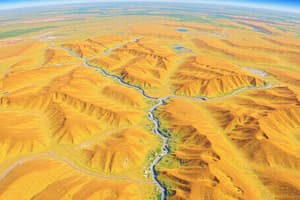Podcast
Questions and Answers
What is the main advantage of lidars over radars in remote sensing?
What is the main advantage of lidars over radars in remote sensing?
- Lidars can penetrate dense clouds and soil surfaces better than radars
- Lidars generally have much higher temporal and spatial resolutions (correct)
- Lidars use longer wavelengths compared to radars
- Lidars have larger instrument sizes than radars
What is the primary component used in LiDAR to measure the earth's surface?
What is the primary component used in LiDAR to measure the earth's surface?
- Visible light laser and altimeter
- Ultraviolet laser and GPS receiver
- Infrared laser and radar detector
- Near infrared laser and scanning mirror (correct)
What can lidar sensors measure in addition to the earth's surface?
What can lidar sensors measure in addition to the earth's surface?
- Chemical composition of soil
- Temperature variations in the atmosphere
- Vegetation density
- Multiple returns from each pulse (correct)
What is a limitation of lidar signal compared to radar in remote sensing?
What is a limitation of lidar signal compared to radar in remote sensing?
What is the wavelength used by lidars in remote sensing?
What is the wavelength used by lidars in remote sensing?
What is the primary difference between lidars and radars in remote sensing?
What is the primary difference between lidars and radars in remote sensing?
What is the function of the scanning mirror in LiDAR measurement?
What is the function of the scanning mirror in LiDAR measurement?
What type of laser is used in LiDAR for measuring the earth's surface?
What type of laser is used in LiDAR for measuring the earth's surface?
What is a characteristic of LiDAR signals in comparison to radar signals in remote sensing?
What is a characteristic of LiDAR signals in comparison to radar signals in remote sensing?
What is a limitation of LiDAR signals in remote sensing?
What is a limitation of LiDAR signals in remote sensing?
Flashcards
LiDAR advantage over Radar
LiDAR advantage over Radar
LiDAR has much better resolution (in both time and space) than radar.
LiDAR Surface Measurement
LiDAR Surface Measurement
LiDAR uses a near-infrared laser and a scanning mirror to measure the Earth's surface.
LiDAR Multiple Returns
LiDAR Multiple Returns
LiDAR can detect multiple layers or surfaces of the ground from the same laser pulse.
LiDAR Cloud Penetration
LiDAR Cloud Penetration
Signup and view all the flashcards
LiDAR Wavelength
LiDAR Wavelength
Signup and view all the flashcards
LiDAR vs. Radar (Key Difference)
LiDAR vs. Radar (Key Difference)
Signup and view all the flashcards
LiDAR Scanning Mirror Function
LiDAR Scanning Mirror Function
Signup and view all the flashcards
LiDAR Laser Type
LiDAR Laser Type
Signup and view all the flashcards
LiDAR Resolution
LiDAR Resolution
Signup and view all the flashcards
LiDAR Signal Limitation
LiDAR Signal Limitation
Signup and view all the flashcards
Study Notes
Advantages of LiDAR over Radar
- The main advantage of LiDAR over radar in remote sensing is its higher accuracy and resolution due to the shorter wavelength of light.
LiDAR Components
- The primary component used in LiDAR to measure the earth's surface is a laser.
LiDAR Measurements
- In addition to the earth's surface, LiDAR sensors can measure vegetation height, building heights, and atmospheric conditions.
Limitations of LiDAR
- A limitation of LiDAR signal compared to radar in remote sensing is that LiDAR signals are more susceptible to interference from atmospheric conditions like fog, dust, and smoke.
- A limitation of LiDAR signals in remote sensing is that they have a shorter range and are more affected by environmental factors.
LiDAR Technical Specifications
- LiDARs in remote sensing typically use a wavelength of around 900-1600 nanometers.
LiDAR vs Radar
- The primary difference between LiDARs and radars in remote sensing is that LiDARs use laser light, while radars use radio waves.
LiDAR Functionality
- The scanning mirror in LiDAR measurement is used to direct the laser beam to different points on the earth's surface.
LiDAR Laser
- The type of laser used in LiDAR for measuring the earth's surface is a near-infrared laser.
LiDAR Signal Characteristics
- A characteristic of LiDAR signals in comparison to radar signals in remote sensing is that they have a much higher frequency and a shorter wavelength.
Studying That Suits You
Use AI to generate personalized quizzes and flashcards to suit your learning preferences.




